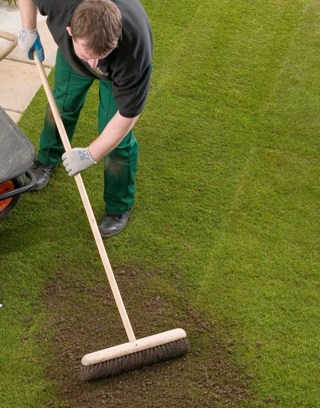Using Compost On Lawns
Using compost on grass, or topdressing, can be very beneficial. As always when you add organic matter to soil, it helps to improve the soil structure and add nutrients, giving all kinds of benefits.
 How to top dress a lawn
How to top dress a lawn
The best time of year to top dress is autumn, although many people also add a top dressing in the spring.
Using compost on grass is not entirely like adding it to a garden bed. You can’t just dump it on top to a depth of a few inches and leave it to rot down over winter. If you try that, which is not recommended, you will find that you have killed off your grass, as it needs air and water to survive.
Instead, first spike your lawn thoroughly, using a garden fork or hollow tine aerator. Then you need to spread a very thin layer of compost across the whole lawn, using a brush or spring-tine rake, and ensure that you can still see all or most of the grass. The lawn should still look broadly green when you have finished, rather than brown.
For general top dressings, aiming to improve the soil structure and provide nutrients in a fairly general way, you can use almost any compost. Home-made is fine, and will give you a glow of satisfaction at feeding your lawn from kitchen and garden waste.
You can buy compost from compost suppliers. Fine Mushroom compost and organic compost are both suitable, laid on fairly thinly (click here to to see our compost range).
Read our three steps to a better lawn article for more information.
A great deal of research has been carried out into the benefits of using PAS100 organic compost as a topdressing on golf courses and other sports turf, find out more here.
Particular top dressings and when to use them
You can also use particular composts and other top dressings to change the acidity or drainage of the soil.
For example, it is common practice to add a top dressing of sharp sand to improve drainage, especially after spiking the lawn in autumn, or if your lawn suffers from waterlogging in winter.
And adding a peat-based compost, which you can buy from compost suppliers, can acidify the soil and discourage worms. So if your lawn seems to have excessive quantities of worm casts, top dress with peat.
A word of warning
It takes a while for any top dressing to settle into the lawn. Try to avoid walking on it immediately afterwards, and prevent children and pets from playing on it for at least a few days, and preferably longer, until the top dressing is no longer obvious. This is not to save your lawn, which will not be affected by the use, but to avoid the risk of carrying compost into the house and dirtying floors! Peat-based composts, in particular, are very dark in colour, and can mark carpets and floors.
If you thick you lawn is beyond repair or you require some turf to patch it, visit our specialist Turf Growers website.
 How to top dress a lawn
How to top dress a lawn